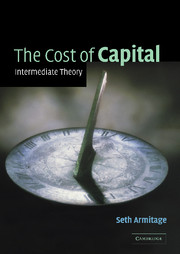Book contents
- Frontmatter
- Contents
- List of figures
- List of tables
- Preface
- Part I Expected Returns on Financial Assets
- Part II A Project's Cost of Capital
- Part III Estimating the Cost of Capital
- 12 The cost of equity: inference from present value
- 13 The cost of equity: applying the CAPM and multifactor models
- 14 Estimating a project's cost of capital
- 15 Regulated utilities
- References
- Index
13 - The cost of equity: applying the CAPM and multifactor models
Published online by Cambridge University Press: 05 June 2012
- Frontmatter
- Contents
- List of figures
- List of tables
- Preface
- Part I Expected Returns on Financial Assets
- Part II A Project's Cost of Capital
- Part III Estimating the Cost of Capital
- 12 The cost of equity: inference from present value
- 13 The cost of equity: applying the CAPM and multifactor models
- 14 Estimating a project's cost of capital
- 15 Regulated utilities
- References
- Index
Summary
This second chapter on estimating the cost of equity reviews the implementation of the standard CAPM and of multifactor models. The dividend discount and abnormal earnings methods infer the cost of equity from the present value of equity and from forecasts of the rewards to shareholders; the analyst solves the discounted cash flow equation for the discount rate. In contrast, the CAPM and multifactor models explain the cost of equity as the risk-free rate plus a risk premium or premiums. The CAPM requires the estimation of three numbers: the risk-free interest rate, the expected equity premium and the project's expected beta. The estimation of these numbers is discussed in turn. We have relatively little to say about the estimation of the risk-free rate, and we have considered the equity premium elsewhere, so much of the chapter is concerned with research on the estimation of beta.
The chapter goes on to consider the implementation of three multifactor models. One is a model in which the explanatory variables are several macroeconomic variables that are commonly used to explain the returns on financial assets. The second is the three-factor model of Fama and French, in which two of the variables are firm-specific characteristics. The third is also a model based on firm-specific variables, with the novel feature that the premiums on the variables are estimated using the abnormal earnings method.
- Type
- Chapter
- Information
- The Cost of CapitalIntermediate Theory, pp. 278 - 299Publisher: Cambridge University PressPrint publication year: 2005



